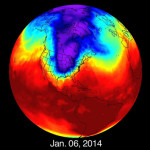Diary of the Future
Jonathan Cloud February 22nd, 2014
February 22, 2014: Climate disruption is becoming increasingly evident in our times. As we begin to thaw out from what has been a surprisingly cold and snowy winter, it seems almost comical to have to ask whether this is somehow connected with global warming. It is. The southward migration of the polar vortex, which we’ve all started hearing about, is partly caused by an upwelling of warm air in the Arctic, causing the center of the vortex to rise and the edges to spill outward. This doesn’t mean that global warming causes it, but only that it likely exacerbates it, continuing a changing pattern of weather events that taken together are what we mean by “climate change.”
[table colalign=”right|center|left”]

NASA Goddard Space Flight Center
[/table]
Wikipedia, as always, brings us plenty of footnoted references:
Beginning on January 2, the breakdown of the polar vortex and subsequent southward movement of tropospheric Arctic air was caused by sudden stratospheric warming(SSW),[12] a phenomenon discovered in 1952. NASA states, “A major midwinter SSW event occurs when polar stratospheric temperatures increase by at least 25 K in one week, and the zonal-mean zonal wind at or near 10 hPa (at about 30 km altitude) reverses direction and becomes easterly north of 60° N.”[13]
In short, we are now living in the age of climate change in a way we haven’t really started thinking about yet: exactly how are we going to adapt to it?